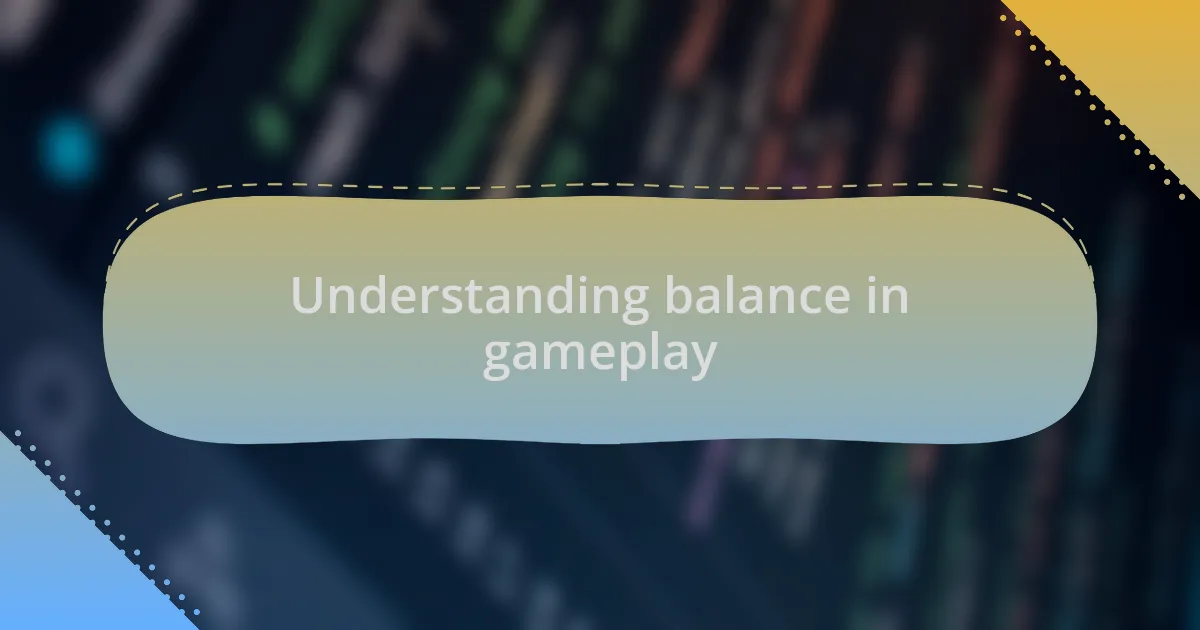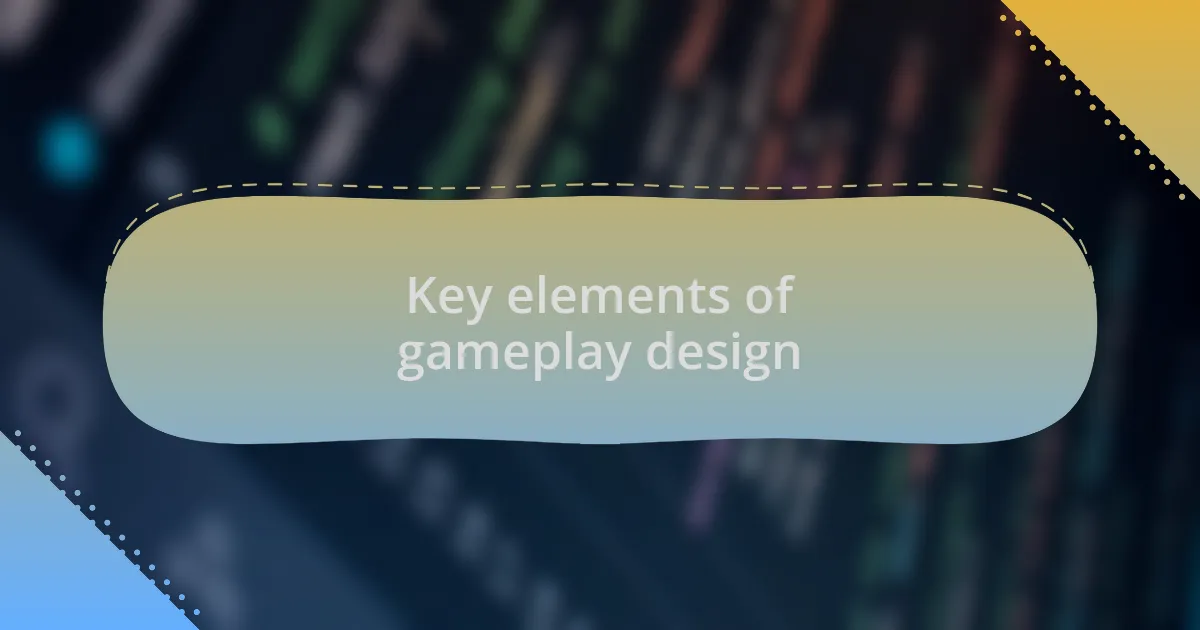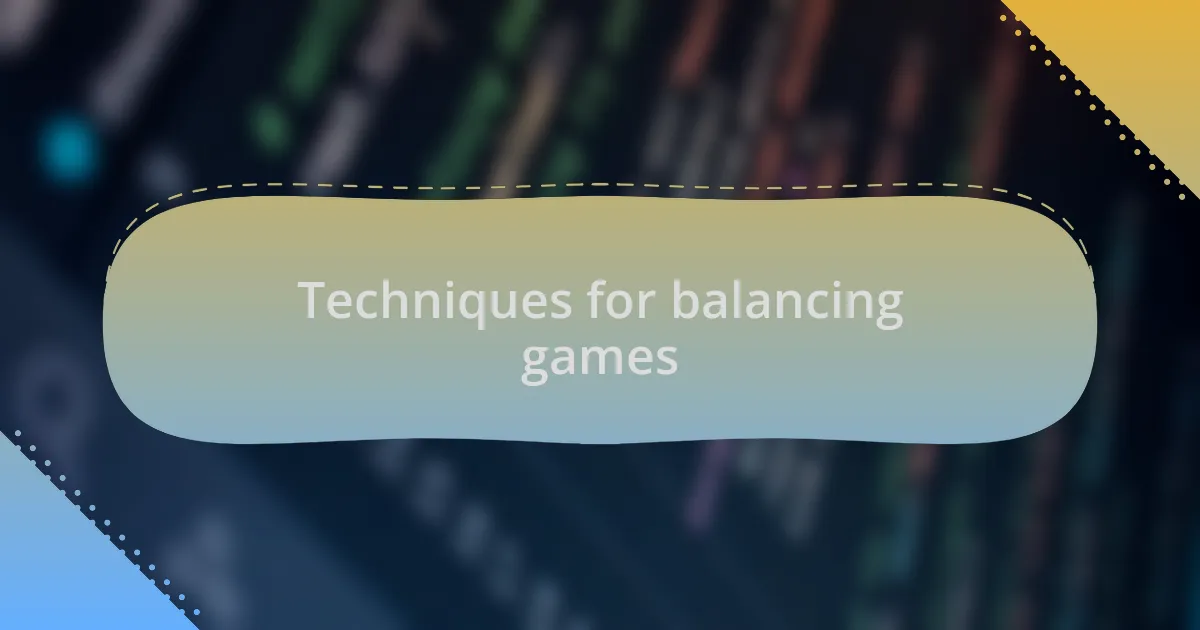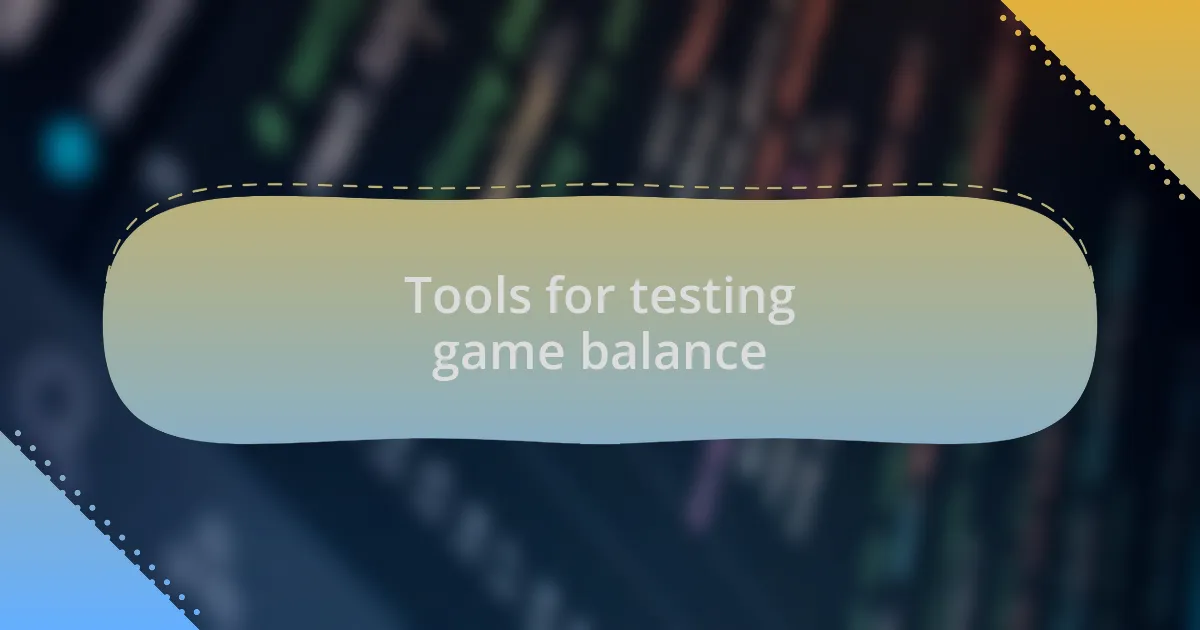Key takeaways:
- Balance in gameplay is essential for player satisfaction and community dynamics, fostering both collaboration and competition.
- Iterative testing, feedback loops, and diverse character options are vital techniques for achieving balance and enhancing player engagement.
- Effective gameplay design requires attention to mechanics, pacing, and aesthetic experiences to evoke emotional connections with players.
- Gathering diverse player feedback and maintaining flexibility in design can lead to significant improvements in gameplay experiences.

Understanding balance in gameplay
Understanding balance in gameplay is crucial for creating an enjoyable experience. I’ve often found myself frustrated when a game favors one strategy or character, leaving others in the dust. It makes me wonder, how can game developers ensure that every element feels valuable?
From my perspective, balance goes beyond just numbers; it involves the interplay of design and player perception. For instance, in one multiplayer game I played, a so-called “overpowered” warrior class made it hard for others to join the fun. This experience reminded me that balance must reflect not only player abilities but also the emotions they evoke. How does a player feel when their favorite character seems ineffective compared to others?
In my journey as a programmer, I’ve learned that playtesting is vital for achieving balance. During one round of testing, I noticed that weapons with similar stats provided drastically different experiences. It led me to realize that it’s not merely about statistics but also how players engage with the game. This intricate dance between gameplay elements can make or break a player’s experience, and that’s something we should always prioritize.

Importance of gameplay balance
Creating a balanced gameplay environment is essential for player satisfaction. I recall a time when I played an online shooter where certain weapons dominated, which led to a major reluctance in trying out different playstyles. It struck me that a diverse set of viable choices keeps players engaged; after all, who wants to feel pigeonholed into a single strategy?
Moreover, balance can significantly impact community dynamics. I once joined a multiplayer game where an imbalance created a rift between players who favored different classes, effectively splitting the community into factions. This experience emphasized that balance is not just about individual enjoyment; it’s also about fostering a sense of collaboration and competition within the game. How can developers cultivate a thriving community if players feel marginalized?
In my view, feedback loops are crucial in maintaining balance. I vividly remember the first time I participated in a game development forum where players were vocal about their experiences. Those insights helped shape the game into something that resonated with many. Listening to player feedback creates a sense of ownership and ensures that the gameplay remains appealing to all. After all, isn’t it critical for every player to have their voice heard in the evolving narrative of a game?

Key elements of gameplay design
Key elements of gameplay design encompass several core aspects that significantly influence player experience. For instance, mechanics like player progression and rewards play a vital role in keeping players motivated. I remember the sense of accomplishment I felt when I unlocked a new character, which inspired me to explore different gameplay strategies. Isn’t it fascinating how a well-structured reward system can ignite a sense of adventure and curiosity in players?
Another essential element is the game’s pacing. I once played a puzzle game that maintained a steady difficulty curve. Each level naturally built on the previous one, allowing me to grasp new concepts without feeling overwhelmed. This balance of challenge and skill is crucial. How often do we find ourselves frustrated because the game feels either too easy or impossibly hard?
Lastly, the aesthetic experience can’t be overlooked. The visuals and sound design create an emotional connection to the game world. I can still recall the haunting soundtrack of a horror game that heightened my sense of immersion. It made each moment feel incredibly tense and engaging. How important is it for games to not just challenge us but also resonate with us emotionally? Aesthetic elements can deeply enhance the overall gameplay experience by making players feel more connected to the journey they’re on.

Techniques for balancing games
One effective technique for balancing games is iterative testing, where gameplay elements are adjusted based on player feedback. I once participated in a beta test for a multiplayer game; the developers frequently adjusted character abilities based on our experiences. It was eye-opening to see how quickly they responded to what was overpowered or underwhelming. What a difference it makes when a team genuinely listens to players!
Another strategy to achieve balance is to implement diverse character classes or options, which cater to different player styles. I recall a strategy game where I gravitated towards a support character, enjoying the role of aiding teammates rather than being on the front lines. This variety not only enhanced my enjoyment but also ensured that every player could find a niche that suited them. Don’t you think allowing players to choose their own path enhances their connection to the game?
Finally, leveraging data analytics is increasingly vital in game design. During a game development camp, I learned how players’ actions are tracked to identify trends. For instance, noticing that players consistently struggle with a particular level can lead designers to adjust difficulty settings. It is fascinating how numbers tell a story, shaping a balanced experience that feels fair and challenging. Isn’t it amazing how data can transform gameplay into something truly engaging?

Tools for testing game balance
When I think about tools for testing game balance, one of my go-tos is playtesting software. For example, I used a platform that allowed my friends and me to simulate various gameplay scenarios over a weekend. It was enlightening to see how even minor tweaks could swing the balance from frustrating to enjoyable. Have you ever watched the dynamics change in real-time? It’s incredibly rewarding to witness.
Using analytical tools like heat maps can also be a game-changer. I recall analyzing player movement in a 2D platformer I was developing. The heat map revealed that players were often getting stuck in one area, which indicated a need for a level redesign. That’s when it hit me: visuals can make data so much easier to digest, painting a clearer picture of where adjustments are necessary. Isn’t it fascinating how a bit of color-coding can lead us to significant design improvements?
Automated testing tools bring a whole new level of efficiency. I remember the first time I incorporated them into my workflow; the software ran thousands of simulation tests overnight while I got some well-deserved rest. When I woke up, the results pointed out patterns I would have missed on my own. It’s like having an extra pair of eyes that never tire. How valuable is that for a developer trying to maintain balance? These tools don’t just streamline the process; they ensure that we learn and adapt quickly.

My personal balancing strategies
My approach to balancing gameplay often begins with creating a solid design document. I remember crafting one for a multiplayer game where I meticulously outlined each character’s strengths and weaknesses. This not only served as a reference point but also ensured that each character felt unique while still fitting into the larger game ecosystem. Have you noticed how a well-structured document can guide your creative decisions? It really aligns the vision of the game.
Another strategy I find invaluable is gathering feedback from a diverse set of players. During a recent beta test, I was amazed at the different perspectives people brought. One player suggested changing a particular weapon’s damage output, which initially seemed minor to me. After implementing their suggestion, I could see how it transformed the gameplay experience. It’s a stark reminder that player input can shape our creations in ways we may not initially consider. Do you ever find that outside opinions can shine a light on blind spots in your designs?
Finally, I always keep a close eye on my game’s pacing. When developing a puzzle platformer, I noticed players were giving up too easily on one segment. That’s when I realized that the timing of challenges mattered immensely; it shouldn’t feel like a chore, but rather an engaging journey. So, I adjusted the difficulty curve, and the response was overwhelmingly positive. How refreshing is it to see players genuinely enjoying the challenge? Balancing pacing has proven to be a key element in crafting a rewarding gameplay experience in my projects.

Lessons from my balancing experiences
One lesson I’ve learned from my balancing experiences is the importance of playtesting early and often. I vividly remember a time when I thought a particular character was perfectly balanced. However, after several rounds of testing, it became clear that players found it overwhelmingly powerful. Seeing the frustration on their faces was eye-opening. Do you think you can spot balance issues without firsthand feedback? I certainly learned that true balance often only reveals itself through actual player interaction.
Another key takeaway has been the necessity of flexibility in my design philosophy. I once built a game mechanic around a specific combat style, convinced it would resonate with my audience. As development progressed, I noticed that players preferred a different approach entirely. It took courage to pivot and adapt, but the end result was a more engaging experience. Isn’t it fascinating how our assumptions can be challenged by the very people we aim to entertain?
Lastly, I’ve come to appreciate the subtlety of emotional engagement in gameplay. In my quest to hold a player’s interest, I remember tweaking elements not just for balance, but for the emotional highs and lows they experience. During one project, a seemingly minor change in narrative timing led to a much deeper connection between players and characters. Seeing players become genuinely invested filled me with a sense of accomplishment. Have you ever felt that a single change turned your work into something truly special? It’s a reminder that balance isn’t just about mechanics; it’s also about feelings.